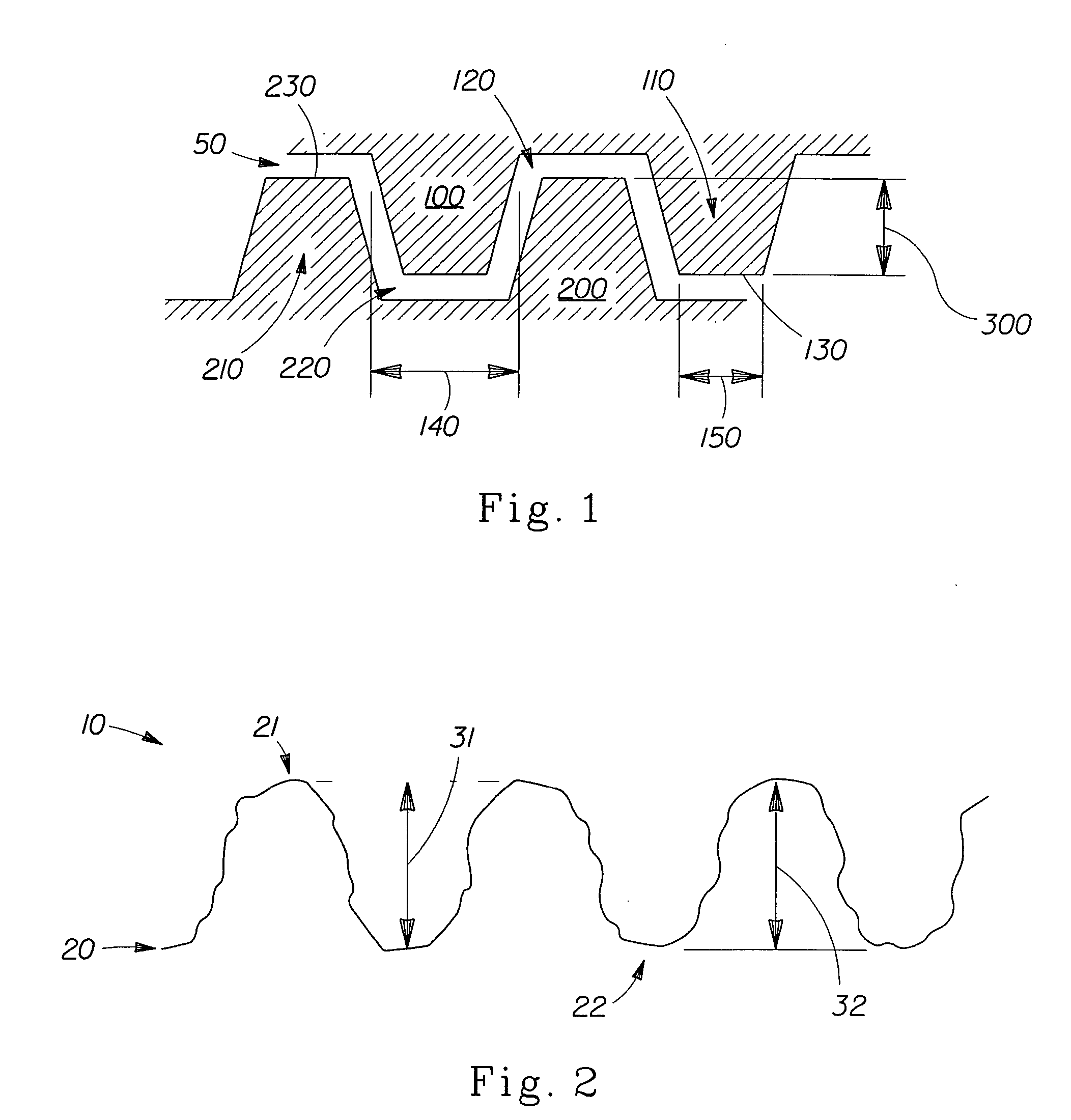High bulk strong absorbent single-ply tissue-towel paper product
a single-ply, high absorbency technology, applied in the direction of patterned paper, manufacturing tools, non-fibrous pulp addition, etc., can solve the problems of reducing the strength and integrity of tissue products, tearing dramatically, and affecting the quality of tissue products
- Summary
- Abstract
- Description
- Claims
- Application Information
AI Technical Summary
Benefits of technology
Problems solved by technology
Method used
Image
Examples
embodiments
Embodiment 1
[0041] One fibrous structure useful in achieving a strong, high CD stretch fibrous structure is the through-air dried (TAD), differential density structure described in U.S. Pat. No. 4,528,239. Such a structure may be formed by the following process.
[0042] A pilot scale Fourdrinier, through-air-dried papermaking machine is used in the practice of this invention. A slurry of papermaking fibers is pumped to the headbox at a consistency of about 0.15%. The slurry consists of about 60% Northern Softwood Kraft fibers, refined to a Canadian standard freeness of about 500 ml, and about 40% unrefined Southern Softwood Kraft fibers. The fiber slurry contains a cationic polyamine-epichlorohydrin wet strength resin at a concentration of about 25 lb. per ton of dry fiber, and carboxymethyl cellulose at a concentration of about 6.5 lb. per ton of dry fiber.
[0043] Dewatering occurs through the Fourdrinier wire and is assisted by vacuum boxes. The wire is of a configuration having 8...
embodiment 2
[0049] In a less preferred example of a through-air dried, differential density structure described in U.S. Pat. No. 4,528,239 may be formed by the following process.
[0050] The TAD carrier fabric of Example 1 is replaced with a carrier fabric consisting of 225 bi-axially staggered deflection conduits per inch, and a resin height of about 0.012″. The resulting paper prior to embossing has a CD peak elongation of about 12%.
[0051] This paper is further subjected to the embossing process of Example 1, and The resulting paper has a caliper of about 0.029″, a CD peak elongation of about 11%, and a wet bursting strength of about 300 g. The resulting paper has a first surface embossment height of greater than 650 μm and a second surface embossment height of greater than 650 μm.
embodiment 3
[0052] An alternative embodiment of the present fibrous structure is a paper structure having a wet microcontraction greater than about 5% in combination with any known through air dried process. Wet microcontraction is described in U.S. Pat. No. 4,440,597. An example of embodiment 3 may be produced by the following process.
[0053] The wire speed is increased compared to the TAD carrier fabric so that the wet web foreshortening is 10%. The TAD carrier fabric of Example 1 is replaced by a carrier fabric having a 5-shed weave, 36 machine direction filaments and 32 cross-direction filaments per inch. The net crepe forshortening is 20%. The resulting paper prior to embossing has a basis weight of about 22 lb / 3000 square feet, CD peak elongation of about 7%, and a wet bursting strength of about 340 g.
[0054] This paper is further subjected to the embossing process of Example 1, and The resulting paper has a caliper of about 0.026 inch, a CD peak elongation of about 6%, and a wet bursting...
PUM
| Property | Measurement | Unit |
|---|---|---|
| Fraction | aaaaa | aaaaa |
| Fraction | aaaaa | aaaaa |
| Fraction | aaaaa | aaaaa |
Abstract
Description
Claims
Application Information
 Login to View More
Login to View More - R&D
- Intellectual Property
- Life Sciences
- Materials
- Tech Scout
- Unparalleled Data Quality
- Higher Quality Content
- 60% Fewer Hallucinations
Browse by: Latest US Patents, China's latest patents, Technical Efficacy Thesaurus, Application Domain, Technology Topic, Popular Technical Reports.
© 2025 PatSnap. All rights reserved.Legal|Privacy policy|Modern Slavery Act Transparency Statement|Sitemap|About US| Contact US: help@patsnap.com

